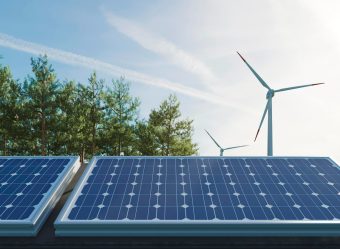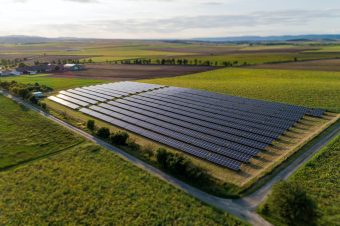
The energy transition is a serious, complex, and longterm process that must be fair. It happens on two tracks – electric power through the construction of new renewable energy sources capacities and reduction of the use of fossil fuels, as well as through the transition of awareness and creating an overall social consensus that the transition to the use of green energy is a useful and necessary process. We talked about this important topic, the relevant Law and plans regarding renewable energy sources in Serbia, with Danijela Isailović, General Manager of the RES Serbia Association.
The Renewable Energy Sources of Serbia Association was founded two years ago to improve the business environment in our country’s RES segment while helping transition from fossil fuels to renewable energy sources and promoting this significant segment in our country. How is our country’s transition to renewable energy sources going?
If we look at the numbers and percentages, Serbia is in an excellent position regarding the use of renewable energy sources. It is well-known that Serbia almost met the ambitious goal of 27 per cent of green energy in 2020, as Eurostat statistical data showed that we reached a 26.2 per cent share. On the other hand, we have had a standstill in recent years, and the fact is that, as of 2019, not one large RES power plant has been connected to the power grid. The reasons are known – the Law on the Use of Renewable Energy Sources provoked great interest and numerous connection requests but did not bring what was prescribed as a priority – new green megawatts on the grid. After the changes to the Law that took place recently, I expect the first round of auctions to take place and the construction of several large wind farms and solar parks with a capacity of up to 10MW. We can conclude that the energy transition is happening on a campaign level. We had a great investment cycle from 2015 to 2019 when new wind farms of almost 400MW capacity were built and a large number of small solar and biogas plants. Then, a four-year hiatus happened. I expect a new tide of construction and investments in the coming years. If this does not happen, then the energy transition is questionable. Nevertheless, I am an optimist, both in terms of private investments and the state’s activities, primarily the Electric Power Industry of Serbia (EPS). The energy transition can only be successful if EPS is the driving force behind that story. Judging by the Kostolac hydropower plant that is finally being built, the announced investments in solar and the Green Road project, which foresees billions of investments in green energy, I think it will happen. As for the transition of awareness, I think there is no dilemma. Citizens are talking and asking about green energy. They understand its environmental, economic and energy importance, and their interest and support are great. We are continuing on our educational mission.
IN FOCUS:
- HYDROGEN IS THE ENVIRONMENTALLY FRIENDLY FUEL OF THE FUTURE
- BIOMASS IS ONE OF THE MOST IMPORTANT SOURCES OF RENEWABLE ENERGY
- MORE ELECTRICITY FROM RENEWABLE SOURCES IN MONTENEGRO
In April 2021, the Law on the Use of Renewable Energy Sources was adopted, as were amendments to it only recently. How do you evaluate the new legal framework?

The passing of the Law on the Use of Renewable Energy Sources in 2021 was a significant step forward in the energy transition and the fight against climate change. The Law sent out an excellent message about Serbia’s direction. Unfortunately, it turned out that the Law was perfect only on paper but unenforceable, which did not produce significant results. More than two years after the adoption of the Law, we have not completed the regulatory framework and its implementation, which was stopped by the key stakeholders in the energy sector – EMS, EPS, and the Energy Agency – who demanded the Law to be changed so that the excessive number of applications for connection (to the power grid) would not collapse the grid itself. Namely, the attractiveness of the Law and the accompanying narrative appealed to numerous foreign investors in Serbia, both serious ones and others, as well as investors from Serbia. All this resulted in a general frenzy regarding the application for connection to the grid, and we found ourselves in a situation whereby EMS AD received approximately 19GW worth of requests for connection to the power grid. Probably only 10 to 20 per cent of those requests are realistic and achievable, but the operator did express their concern and subsequently asked for the regulation to be changed.
As an Association, we advocate stricter criteria when securing a place in the grid, both in terms of the documentation required when applying and in terms of providing financial guarantees, namely, a guarantee that a certain investor will build a plant that will produce the number of megawatts for which they are requesting a connection.
The new amendments bring fundamental changes in the renewable energy sources sector, as they are expected to implement new projects after the first auctions are held this year and probably the new cycle next year. Now we expect the adoption of by-laws, primarily the Balancing Decree and other legal acts that are currently missing.
The RES Serbia Association actively participated in a public debate and gave comments on the amendments to the Law on the Use of Renewable Energy Sources. Which of your most important suggestions were accepted and which were not?

At a public debate, the Association gave a series of comments on the draft Law following the instructions and comments of our members who submitted their proposals and suggestions. By accepting specific comments, the Ministry of Mining and Energy gave us a clear sign of support and expressed the desire for further development of power plants that use renewable energy sources for generating energy. The most significant objection that has been accepted is that if the Facility Connection Study (which has been drafted and adopted by the transmission system operator as per the Law on Energy) shows the need for additional electricity storage, such projects will have priority when it comes to the connection to the grid, concerning other projects. This objection has been accepted so that projects providing storage will not be delayed in terms of connection.
I must underline that the prices of raw materials, equipment, logistics and transportation for wind and solar farms have increased drastically, just like the costs of construction, financing, and insurance of projects. There are still major problems with the supply chain. This indicates that investors will only be willing to participate in auctions if the Serbian government offers a sufficiently attractive and competitive price. Unfortunately, we missed the period when the cost of investments in renewable energy sources was low, and during that period, we had no construction going on. Like investors in most European countries, we are facing difficulties and financial challenges.
Interviewed by: Milica Radičević
Read the story in the new issue of the Energy portal Magazine RENEWABLE ENERGY SOURCES



